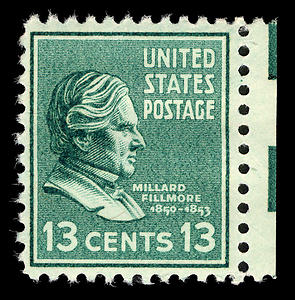Millard Fillmore
| ||||||||||||||||||||||||||
Millard Fillmore (January 7, 1800 - March 8, 1874) was the thirteenth (1850-1853) President of the United States and the second President to succeed to the office from the Vice Presidency on the death of the predecessor. He succeeded Zachary Taylor, who died of acute indigestion.
Biography
Born in extreme poverty, he worked his way up through the Whig party, eventually being selected as Zachary Taylor's running mate. It was thought that the obscure, self-made candidate from New York would complement Taylor, a slave-holding military man from the south. Nevertheless, the two men came to a head on the slavery issue in the new western territories taken from Mexico in the Mexican-American War. Taylor wanted the new states to be free states, while Fillmore supported slavery in those states in order to appease the South. In his own words: "God knows that I detest slavery, but it is an existing evil ... and we must endure it and give it such protection as is guaranteed by the Constitution."
Fillmore presided over the Senate during the months of nerve-wracking debates over the Compromise of 1850. He made no public comment on the merits of the compromise proposals, but a few days before President Taylor's death, he intimated to him that if there should be a tie vote on Henry Clay's bill, he would vote in favor of it.
Thus the sudden accession of Fillmore to the Presidency in July 1850 brought an abrupt political shift in the administration. Taylor's Cabinet resigned and President Fillmore at once appointed Daniel Webster to be Secretary of State, thus proclaiming his alliance with the moderate Whigs who favored the Compromise.
A bill to admit California still aroused all the violent arguments for and against the extension of slavery, without any progress toward settling the major issues.
Clay, exhausted, left Washington to recuperate, throwing leadership upon Senator Stephen A. Douglas of Illinois. At this critical juncture, President Fillmore announced in favor of the Compromise of 1850. On August 6, 1850, he sent a message to Congress recommending that Texas be paid to abandon her claims to part of New Mexico.
This helped influence a critical number of northern Whigs in Congress away from their insistence upon the Wilmot Proviso--the stipulation that all land gained by the Mexican War must be closed to slavery.
Douglas's effective strategy in Congress combined with Fillmore's pressure from the White House to give impetus to the Compromise movement. Breaking up Clay's single legislative package, Douglas presented five separate bills to the Senate:
- Admit California as a free state.
- Settle the Texas boundary and compensate her.
- Grant territorial status to New Mexico.
- Place Federal officers at the disposal of slaveholders seeking fugitives.
- Abolish the slave trade in the District of Columbia.
Each measure obtained a majority, and by September 20, President Fillmore had signed them into law. Webster wrote, "I can now sleep of nights."
Another important legacy of Fillmore's administration was the opening of Japan to American trade under Commodore Matthew Perry.
Some of the more militant northern Whigs remained irreconcilable, refusing to forgive Fillmore for having signed the Fugitive Slave Act. They helped deprive him of the Presidential nomination in 1852.
Within a few years it was apparent that although the Compromise had been intended to settle the slavery controversy, it served rather as an uneasy sectional truce.
Upon completing his presidency, Fillmore returned to Buffalo, where he served as rector of the local university. As the Whig Party disintegrated in the 1850's, Fillmore refused to join the Republican Party; but, instead, in 1856 accepted the nomination for President of the Know Nothing, or American, Party. Throughout the Civil War he opposed President Lincoln and during Reconstruction supported President Johnson. He died in 1874 with his last words, upon being fed some soup on his deathbed, were "The nourishment is palatable."
The myth that Millard Fillmore installed the White House's first bathtub was started by H. L. Mencken in a joke column published on December 28, 1917 in the New York Evening Mail. [1]
Supreme Court appointments
- Benjamin Robbins Curtis - 1851
Related articles
| Preceded by: Zachary Taylor |
Presidents of the United States | Succeeded by: Franklin Pierce |


